#and about history
Explore tagged Tumblr posts
Text
So last night as I was starting to slowly drift off to sleep, my brain suddenly stuck on something (I promise this is Temeraire related). You see, the Netherlands have used "can't get an army across lots of water" as a basic defence strategy pretty much from Roman times until we got airplanes. The extent of it has varied; sometimes it was as simple as "well the river is too big" (Romans), sometimes it was "if we break this dike right here, the polder will flood and the Spanish can't get at the city". But, from the end of the 17th century, there was a systematic line of forts along the polders and rivers that could protect the province of Holland (specifically), here shown in purple. To the south there's big rivers leading into an estuary, and then it protects the province from invasion to the east. From about 1870, it was replaced by the orange parts, as well as the brownish line around Amsterdam specifically. The yellow area is from the mid-18th century. It is basically a collection of forts, and a series of locks. Together, these can make it so the coloured areas flood to a depth of 30-60 cm. Too deep for infantry, not deep enough for boats. It protects the capital of Amsterdam (with its important harbour), and the big cities of The Hague, Utrecht and Rotterdam.

And again, until we developed airplanes and parachutists and airplane bombs and so on, this worked really well.
Now, since I've been rereading the Temeraire books, the drifting off to sleep made me suddenly realise - how would dragon aerial warfare interact with this? Which morphed into a discussion with my partner (who hasn't read the books) about how Dutch dragons would work.
The first thing I'd like to do is point out the size of the Netherlands, compared to the British Isles and to the United States:


In other words, very small. And, very importantly, it used to be even smaller; a lot of the current land was reclaimed from the sea or large lakes between roughly 1650 and 1950. Most of the west of the country is below sea level, and very wet. A fair part of the east of the country isn't very rich soils and thus not great for farming (until chemical fertiliser is invented in the 1900s) (though they did use sheep dung as fertiliser, and they would almost certainly have thought of using dragon dung as well, eventually).
So I propose that actually, the Netherlands probably would have mostly had middle- and lightweights. There just isn't the area to support a large enough population of heavyweights that they aren't all inbred. My partner suggested there is probably one heavyweight breed, and I like that idea. I think that - militarily - the Netherlands would probably have figured out a strategy for using middle-weights against heavy-weights when they are fighting alone, but preferentially use their middle-weights as support in battles when there is a larger coalition, joining whoever is on their side.
However. There may only be middle-weight dragons, there would be a fairly large number of different breeds, with different strengths. You see, unlike the United Kingdom, where England was mostly united by around 900 CE, and then the Normans strengthened that, or France, which has a similar time scale, the Netherlands is a collection of loose duchies and counties and prince-bishoprics and so on, pretty much until the 1550s. The map pictured is from 1670, after a fair amount of the lands have been united into a republic; there would likely have been more divisions before then.
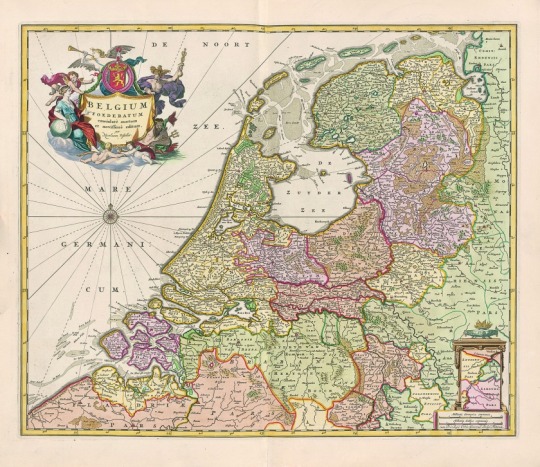
They get united under the dukes of Burgundy, eventually, but even at that time, it is still the Duchy of Brabant and the County of Holland and so on. But until they come together against Spanish rule, the separate parts regularly fight with each other. Which means that each of them would have their own breeds. (Likely, Holland and Zeeland would have very similar dragons, with aquatic adaptations, who get fed on a mixture of fish and meat; the more inland regions would have more "standard" breeds. To outsiders they all look incredibly alike, but if you mention to someone from Guelders that you cannot tell their Zwarte van Gelre apart from the Brabants Blauwtje, they would be so insulted. Can you not tell that theirs is a pure midnight black while the Brabants Blauwtje is blue? However, the breeds are so alike that most of them follow a continuum. Except the Fryske Grutskens, which looks very distinct). This is also where the single heavy-weight breed comes in - I think it would have been Flanders. Flanders is a part of the kingdom of France (rather than the Holy Roman Empire, which is the power the rest of the motley collection belongs to). One of the counts of Flanders probably got a breeding pair of heavy-weights from the king of France; maybe during one of the (many) revolts. These were crossed with the native middle-weights until a new breed of heavy-weights was developed. And finally, purely for my own amusement, William the Silent/William of Orange, who led the 1548 revolution against the Spanish, would have a dragon that is actually orange. No one knows how or why it came out that colour, none of its progenitors was, it just did and he was named for it (the fact that he is Prince of Orange is a bonus).
I also think that the Dutch would be using dragons for shipping, at least within the country. It is efficient and cheap (especially the dragons that grew up having fish as part of their diet), and the Dutch have always been fans of efficient and cheap and trade. And since it's all middle-weights, that is less scary than heavyweight breeds dropping in. I don't think dragons would be used for passenger-work, but loading the big ships, that can't quite reach the harbour? Definitely. And if you have large-ish ships, but only middle-weight dragons, it's probably much easier to ship dragons across the world, so you can also have a dragon when you arrive at your destination.
To bring it back to the idle thought that started this all - the Waterlinie, aka using the water to prevent invasion. My partner and I think it would still have worked, mostly. The Romans start taming the native European breeds, so they probably could cross the Rhine. In our world, the Rhine was the limes, the border, because they can't cross it in large enough numbers; but if they have dragons and the native Germanic tribes don't, then they can. I don't think they'd have been able to hold the land, not for long, and it's not interesting enough to bother anyway. But after that, when the playing field is levelled by everyone having dragons, the water would still be a workable defence. Yes, the aerial forces can come over and wreak havoc - except everyone has dragons now and so they will try to defend it - but the infantry still has trouble crossing the water. And then, when artillery gets developed, it's still the same. You can shoot at the enemy dragons, they can shoot at yours - and the infantry still can't cross the water. I think an enemy (often the French) would try to use dragons against the forts, before they can inundate the land, but that it wouldn't work as well after.
Anyway, here are some rambly thoughts about Dutch dragons in the Temeraire universe. (Sidenote but I can't make heads nor tails of the Dutch names that are used once or twice in the books. They just don't work.)
#lioness rambles#temeraire#many thoughts about dutch dragon breeds apparently#and some about strategy#and about history#can you tell that any time i read or reread those books my brain gets consumed by them#long post
14 notes
·
View notes
Text
1963 Refrigerator 🤔
#pay attention#educate yourselves#educate yourself#knowledge is power#reeducate yourself#reeducate yourselves#think about it#think for yourselves#think for yourself#do your homework#do some research#do your own research#ask yourself questions#question everything#american history#history lesson
75K notes
·
View notes
Text
if you’ve never played a pokémon game you’re missing out on the insane things npcs will say to you unprompted. like you’ll be walking down a path and a total stranger will see you and immediately run up to you and trap you in place and say something like ‘the divorce is getting rough but me and my pokémon are getting tough!’ and then start a battle and after you beat their single rat they’ll be like ‘i wasn’t worthy of her…’ or something
#goldie plays pokémon black… 2!!!#i appreciate the infodump about your clothing man idk#i don’t need to hear about your medical history please#hall of fame i guess#hey everyone check out my pokémon liveblog while you’re here it’s a fun ride
28K notes
·
View notes
Text

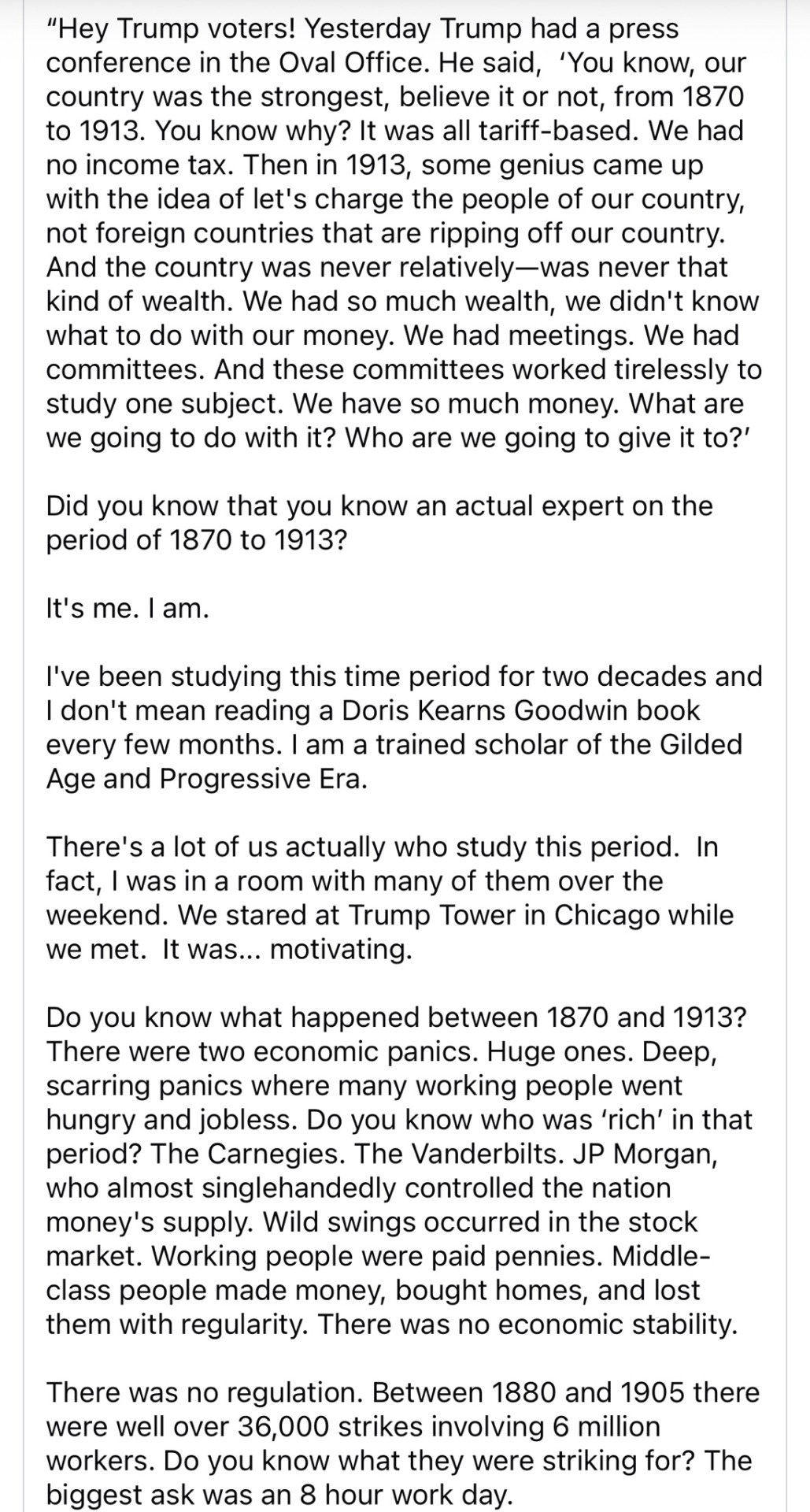
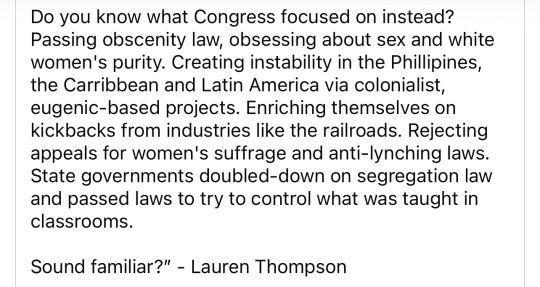
#Lauren Thompson#historian#gilded age history#Vanderbilts#JP Morgan#The Carnegies#stock market collapses#tariffs#economic panics#oligarchs ran rampant#unrestrained capitalism#republican assholes#maga morons#crooked donald#traitor trump#tangerine tariff taint#republican hypocrisy#corporate greed#Trump has no clue about economic policy
14K notes
·
View notes
Text
i had a thought of "do people not know what AUs are anymore?" and then i remembered nobody explains fandom stuff to new people anymore so it is entirely plausible people genuinely don't know what AUs are and nobody has explained it to them, so for today's lucky 10,000:
"AU" stands for "Alternate Universe" or "Alternative Universe" (same difference) and is basically any thought scenario for a fandom that isn't canon and can't fit within the canon universe. If it takes place in the canon universe but something is notably different, that is typically what's known as a "Canon divergent AU," because it diverges from canon.
an AU can be absolutely anything. There's a couple of widespread pan-fandom au scenarios that often get thrown around, like coffee shop aus, genderbend aus, hanahaki aus (hanahaki is a whole thing in itself i'd recommend researching on your own), etc. One you might hear sometimes is "crossover AU" which is when you have characters from one fandom interacting with characters from another.
You can have as many aus as you want. They can be whatever you want and you can do whatever you want in them. It's a sandbox for you to play around in and explore how things would be different or how the characters would act in those circumstances or environments. Maybe they have different relationships with each other. Maybe they behave slightly differently. Or you can just say "Okay, [x] is true. How did they get here? How would things have to be different for this to occur?" which can also be fun.
If you are ever confused about why people ship something that seems completely out of the blue or doesn't make sense to you in the canon setting, there's a good chance they like it in an AU setting! Not everything everybody is interacting with is necessarily the canon! Not everybody wants things to exist in canon and just want to explore playing dolls in a different sandbox and that's okay. And their sandbox might look a lot different than yours, and that's also okay. You have the freedom to make your sandbox whatever you please. Do whatever you want forever. Get funky with it. AUs are fun.
Okay that's my schpeal. everybody go have fun and play nice now.
#fandom#fandom infrastructure#fandom history#was working on the ship polls blog and the comments i get there often reminded me of this#every once in a while i've gotta reacquaint myself with the xkcd expert familiarity comic principle#and the general knowledge that people dont explain the basics of fandom anymore so people have to learn it on their own#while everybody just expects them to know it and that's not fair to them!#i will also put my usual thing: folks are always welcome to ask me anything about fandom stuff#it can be specific pjo fandom stuff or general pan-fandom stuff#i have been in fandom for a long time and i am happy to explain things#legitimately if anyone ever has questions about even the most basic of fandom stuff. go for it. i love talking about it
9K notes
·
View notes
Text
this is just my opinion but i think any good media needs obsession behind it. it needs passion, the kind of passion that's no longer "gentle scented candle" and is now "oh shit the house caught on fire". it needs a creator that's biting the floorboards and gnawing the story off their skin. creators are supposed to be wild animals. they are supposed to want to tell a story with the ferocity of eating a good stone fruit while standing over the sink. the same protective, strange instinct as being 7 and making mud potions in pink teacups: you gotta get weird with it.
good media needs unhinged, googling-at-midnight kind of energy. it needs "what kind of seams are invented on this planet" energy and "im just gonna trust the audience to roll with me about this" energy. it needs one person (at least) screaming into the void with so much drive and energy that it forces the story to be real.
sometimes people are baffled when fanfic has some stunning jaw-dropping tattoo-it-on-you lines. and i'm like - well, i don't go here, but that makes sense to me. of fucking course people who have this amount of passion are going to create something good. they moved from a place of genuine love and enjoyment.
so yeah, duh! saturday cartoons have banger lines. random street art is sometimes the most precious heart-wrenching shit you've ever seen. someone singing on tiktok ends up creating your next favorite song. youtubers are giving us 5 hours of carefully researched content. all of this is the impossible equation to latestage capitalism. like, you can't force something to be good. AI cannot make it good. no amount of focus-group testing or market research. what makes a story worth listening to is that someone cares so much about telling it - through dance, art, music, whatever it takes - that they are just a little unhinged about it.
one time my friend told me he stayed up all night researching how many ways there are to peel an orange. he wrote me a poem that made me cry on public transportation. the love came through it like pith, you know? the words all came apart in my hands. it tasted like breakfast.
#warm up#writeblr#actually this is because again i don't go here#i don't read/write fanfic but i have nothing but respect for my troops#but i also have never played minecraft. im sorry. please ask me any question about pokemon tho i love that shit#anyway#out of some banal and thoughtless curiosity i watched the minecraft movie trailer#and again i know nothing about minecraft. i am aware im in an endangered population#but im watching this going: this is so fucking.... BAD#there is NO LOVE in it!#like if someone who has NO history in minecraft watches that and is like - ohhh this is soulless#WHO IS THE AUDIENCE????#ppl who love minecraft are gonna hate it!!!#at some point it's the ''mean girls musical movie'' problem --#some people will always hate the premise of what you're doing and some people will love it#make it for the ppl who love it#and usually that somewhat convinces the haters to like. chill enough to TRY it . bc it IS good#but when you try to make it for the haters..... nobody likes it. it doesn't have passion. energy. footwork#which is a small way of saying a big thing: if you love something. fucking make it and assume someone will love it too.#i love u . be brave . be bold. be in boston and come to my reading#where i wrote a really weird fucked up little book.#love u love u love u etc
13K notes
·
View notes
Text
Tell me you know nothing about history without telling me you know nothing about history

#'turned him gay'#newsflash asshole he's been gay (bi rather) the entire time!#alexander the great#history#to clarify this is a reaction to the tweet#I don't know anything about the documentary itself or how accurate it is
53K notes
·
View notes
Text
At least once a month I remember that Ozai ruled for ~3 years. That's shorter than one presidential term. That's nothing. In comparison Zuko - who suffered so much cruelty and was made to feel worthless under Ozai - ruled for ALMOST 70 YEARS. That's more than 22 times the length of Ozai's rule - and he will go down in history as one of the most influential and well loved Fire Lords of all time
#i'm almost positive i've made a post about this before because this just kills me#avatar#atla#my posts#zhao made a big stink about being remembered by history then quickly died in obscurity#like ozai!!! he's a foot note in history and so much of his story is linked to zuko and aang's!!!
13K notes
·
View notes
Text
"Blorbo from my shows" no. Blorbo from my BA. Blorbo from my major. Blorbo from my primary source document.
#this is how i feel about orestes and antilochus#you all get it#tagamemnon#classics#history#ancient history
45K notes
·
View notes
Text
hero/villain showdown but one of them has a spontaneous medical emergency and the battle gets put on hold while their archnemesis drives them to Urgent Care
#it should be like. a hernia. or diverticulitis#something intestinal for maximum Awkward Scenario#and the entire car ride alternates between awkward silence and the driver lecturing their nemesis on the importance of regular check-ups#this is funnier if the hero is the one having the hernia tbh. but both options are Very Good#want to emphasize that it is a 'medical emergency ' that is clearly not extreme enough for the emergency room#and the sidekick/henchperson gets stuck in traffic so the hero/villain stays for moral support#they spend 8 hours in the waiting room playing Uno (it devolves into a screaming match)#at the end of the ordeal one of them vows to burn the hospital to the ground with their laser eye powers#and it's Not The One You Think#oh oh oh! ALTERNATIVELY:#it's an allergic reaction; one of them accidentally poisoned the other by using like. soybean derivative in a tranquilizer dart#emphasis on *accidentally*. yes they were technically fighting but That Wasn't Supposed To Happen#so now they're obligated to take responsibility and Stay In The Waiting Room#(can't decide if it's funnier if it's the hero or the villain stuck in this situation)#(probably the villain)#“why didn't you TELL me you were allergic to soybeans???”#“um because you would use it against me in combat?”#“as opposed to NOT telling me! which has worked out fantastic for you!!!”#villain being genuinely offended bc they have a biochemistry degree and have invented literally dozens of untraceable poisons#they have the scientific skill to poison their favorite jackass in hundreds of ways#(and have done so before! in admittedly non-fatal outcomes but that was by design okay)#but it's “dangerous” to do them the simple curtesy of informing them about a SOY ALLERGY????#above all else they consider themself a scientist#and they're LIVID that their favorite (reluctant) test subject lied about their medical history#“technically i didn't LIE--#“I read you the questionnaire! the very first time i held u hostage i READ YOU THE QUESTIONNAIRE!!!”#“...the what now”#“the MEDI--holy shit you weren't even paying attention were you#i had you bound and gagged over an ACTUAL BUBBLING ACID PIT and you couldn't even be bothered to--#“--so i was obviously a bit BUSY at that moment! I'm sorry i ignored your VILLAINOUS MONOLOGUING while the BLOOD WAS RUSHING TO MY HEAD but
6K notes
·
View notes
Text
Old Lighters 🤔
#pay attention#educate yourselves#educate yourself#knowledge is power#reeducate yourself#reeducate yourselves#think about it#think for yourselves#think for yourself#do your homework#do some research#do your own research#ask yourself questions#question everything#old lighters#lighters#antique#history lesson#history#american history#world history#ancient history
25K notes
·
View notes
Text
academic bias is so funny because you’ll be reading about the same historical event and one person is like “Despite the troubles that befell his homeland and near constant criticism of the court King Blorbo remained strong in the face of adversity” and the other one is like “after letting his people carry the brunt of his cringefail decisions Blorbo the Shitface refused to listen to any reason and continued to be a warmongering piece of shit. Also he was ugly.”
#historians are out there beefing with ppl who died over 200 years ago. good for them#history#history memes#this isn’t really about anyone in particular#but I did read the most hilariously bitter takes on alexander I#not that it’s hard to poke fun at his vanity and indicisive nature but like. he was just a poor little meow meow#although I have some weird grudges against dead ppl as well *cough* Catherine II *cough*
36K notes
·
View notes
Text






























The stewards of the old world are always keen to give you a glimpse of their might... According to legend, the ancients built specialized chambers to seal away false prophets.
The Arcane is waking up.
#arcane#melvik#mel medarda#mel arcane#viktor#viktor arcane#spoilers#arcane spoilers#arcane s2#wake up friends - mel and viktor are doing that thing again#I was mentally out of commission after act 2 but after sitting and thinking about this? season 1 parallels were crazy. but this. is INSANE#by the way - this is nowhere near all of them. i did not include dialogue. this MIGHT be HALF of them. i hit image limit here#at this point i don't know whose fight is gonna be crazier. viktor and jayce's or viktor and mel's lolololol#i support mage on mage violence#okay real talk. why are mel and viktor explicitly paralleled more than basically any other characters#it's bc this is the story of the Arcane literally. they are piltover and zaun's only mages respectively. the Arcane is waking up etc.#the macro narrative is about different kinds of magic rising to power again in a place like piltover/zaun which is a refuge from mages#and it's about how they clash - or work together - because the history of the rune wars is repeating itself#also viktor was a false prophet and mel... may not be#it's because the Arcane speaks through them and the show is about what that means and the consequences
7K notes
·
View notes
Text
Is she a "forgotten woman of history" or is this just the first time you've personally heard about her?
3K notes
·
View notes
Text
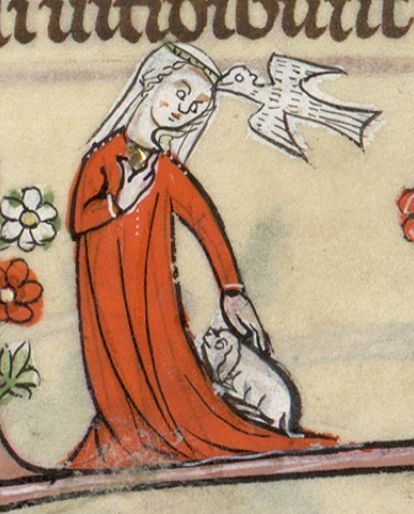

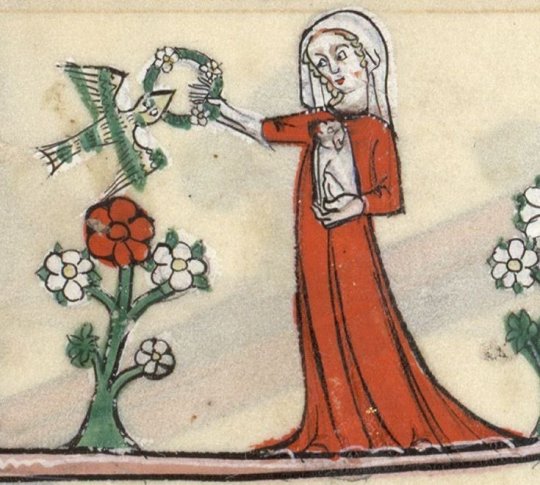
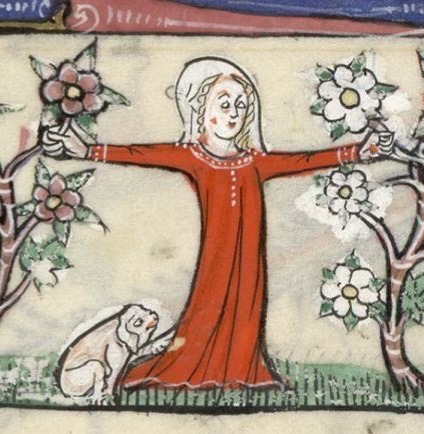
I can't stop thinking about this medieval girl and her dog ❤️🥲
(Les Trés Riches Heures de Metz, 14th century)
#she is so relatable#middle ages#medieval#history#medieval girl#i wish i knew more about her#14th century
7K notes
·
View notes